Introduction
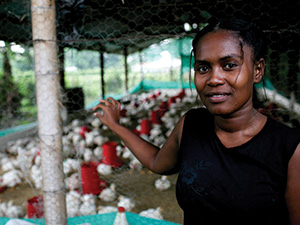
Feed the Future is a U.S. Government initiative that explicitly aims to improve nutrition through agriculture-led activities that also strive to reduce rural poverty in 19 focus countries. The initiative strives both to improve nutrition where it works and to contribute to the evidence base demonstrating how agriculture affects diet and nutrition for rural families. There is growing international agreement on key pathways1 and principles2 for improving nutrition through agriculture, as summarized in Understanding and Applying Primary Pathways and Principles (Brief 1). However, there is still a lack of well-documented examples of programming at scale that are required to improve our understanding of how agriculture can best contribute to improved nutrition.
This brief focuses on the pathway from agricultural income to better diets, health, and nutrition, illustrated in blue in the figure below. However, all of the pathways are interrelated. Agricultural activities typically affect more than one pathway and interact with the enabling environment that includes policies, the natural resource base, and cultural practices, among other factors.
Steps Toward Improved Nutrition: The Agricultural Income Pathway
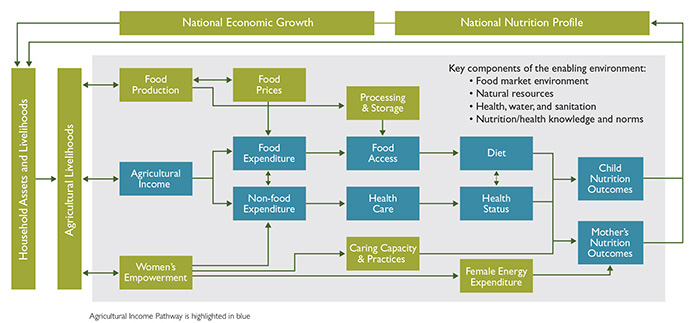
Agricultural Income
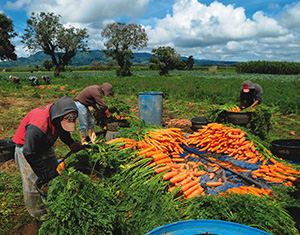
The agricultural income pathway is not linear; the effect of income on diet, health, and nutrition is modified by:
- Characteristics of food markets—the availability, affordability, convenience, and marketing of foods of varying nutritional quality and safety.
- The extent to which women and men are differentially empowered to make decisions about household food purchases, dedication of land to production of food for household use versus markets, and other decisions that impact household nutrition.
- The knowledge and social norms that reinforce the use of income on goods and health investments that benefit nutrition.
Overall, income and nutrition are related. Child nutrition is usually more adequate in wealthier households than in poorer ones. However, the correlation is not always as strong or inevitable as might be expected. For example, in Ethiopia, where 80% of the population is employed in agriculture, child stunting rates are 40%, even in households of the highest-income quintile (Central Statistical Agency 2006).3
From the Feed the Future Learning Agenda
Agricultural Income in Focus
- Have programs intended to increase farmers’ incomes resulted in improved nutrition when not coupled with nutrition programming?
- Does including nutrition education and/or SBC in agriculture extension services lead to reductions or elimination of household hunger and improved dietary diversity?
- Which types of investments in market-led development result in poverty reduction and improved nutrition among the lower-income quintiles in areas where value chain work is taking place?
- Which kinds of investments and which value chain functions have generated increases in income and opportunities for employment among the poorest quintile, among women, and within other vulnerable groups?
Research shows that income generation can have a positive, negative, or neutral effect on nutrition within agricultural projects (World Bank 2007). This variability is likely associated with the modifying factors listed above as well as trade-offs that may affect other pathways to nutrition, such as the health and natural resources environments. More time spent by women generating income could negatively affect breastfeeding and other child care responsibilities. Practitioners have observed that growing more cash crops has less effect than changes in on-farm food production on diversifying and improving the quality of diets among smallholder households (Food and Agriculture Organization of the United Nations 2013). Smallholder farmers must balance decisions between how much of their land to dedicate to cash crops and how much to set aside to grow food for family consumption.
Feed the Future activities can play a large role in directing such decisions in targeted zones of influence. Including opportunities for both men and women to better understand key diet and nutrition practices as a part of agriculture activities may help households spend income earned on nutrient-dense foods that they are unable to grow themselves.
There are many gaps in research associated with the link between increased income and nutritional status. For example, few activities have adequately measured income generation disaggregated by gender. It is also unclear how much nutrition education and social and behavior change (SBC) affect food purchase decisions from one context to the next. There is a need for better understanding about how to influence prioritization of spending to ensure a nutritious diet while meeting other needs, including food, housing, clothing, health, education, social and religious obligations, and pleasure. Maximizing SBC impact requires a better understanding of who receives the information, what form it is delivered in, and how it fits into existing knowledge structures. Feed the Future has recognized these evidence gaps and is addressing many of them through research questions that are part of the initiative’s learning agenda.4
The following vignettes speak to these questions-in particular, how agriculture and nutrition activities have worked concurrently with activities that aim to empower women, use nutrition SBC, or improve the food market environment to effectively link income generation and nutrition.
Agriculture Income Pathway in Focus: Mozambique
In Mozambique, Henrique Hilário Avela is proud of his new three-bedroom house in town and talks of his plans to paint and furnish it. He also talks of his dreams of buying a truck and a tractor and of opening a retail shop. He was one of the first farmers to work with the International Institute of Tropical Agriculture (IITA) to diversify his production away from the range of crops traditionally grown in his community and begin cultivating nutrient-dense soybeans. A portion of his land also serves as a demonstration plot for other farmers.
Public–Private Partnership for Innovation in Soybean and Cowpea Value Chains
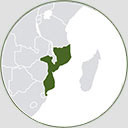
Location: Nampula, Manica, and Tete Provinces, Mozambique
Implementer: International Institute of Tropical Agriculture (IITA) and partners
Timeframe: 2010–2015
Key Interventions: Cowpea and soybean production and market development; home food processing; business skills
IITA and its partners are assisting Mozambican farmers to increase their incomes by cultivating soybeans and cowpeas. In addition to increasing purchasing power of target farmers, the activity strives to increase availability of nutrient-dense foods (legumes) for consumption at home and for sale and purchase in local and regional markets. The activity helps build partnerships among soybean and cowpea value chain stakeholders. At the same time, training and demonstrations showing new cultivation techniques are being presented. New home processing technologies are also being introduced, enabling smallholder farm families to produce and consume new soybean- and cowpea-based food products with high nutritional value. Seventy-three farmers established soybean demonstration plots, enabling comparison of the new varieties they grow. This new knowledge, paired with business skills that famers are also learning, helps them make more informed decisions about growing and selling their crops. Farmers also use the plots to learn about better production, better management, and better post-harvest storage and processing practices. In addition, participants can provide feedback on the training’s effectiveness. One involved farmer explained:
“This project has changed the entire Malema District. Until 2011, people thought only of maize, onion, and a few vegetables. After seeing and experiencing the benefits from soybean, both economically and health-/nutrition-wise, people have become wiser. Most of us are now growing maize only for home consumption and devote the rest of the land to soybean. Most farmers are now trying to legalize their lands because even a small parcel with soybean can improve their lives.”
Opportunities for Nutrition Linkages
Following the agricultural income pathway, IITA is strengthening links between agricultural activities and nutrition outcomes. Several opportunities to further apply the pathway and principles include:
Nutrition Knowledge: Although IITA’s success in increasing income has been notable, improving farmers’ awareness of the nutritional importance of consuming a diverse diet may require more effort. While consumption of soybeans is being promoted, nutrition education and SBC efforts are needed to help farmers prioritize the purchase and consumption of a variety of nutrient-dense foods. This should be accompanied by research to determine key underlying contributors to malnutrition in the target area.
Natural Resource Environment: Soybeans fix atmospheric nitrogen in the soil, which enriches it and increases potential for relay cropping with other nutrient-dense foods for consumption or sale.
Production Diversification and Food Market Environment: IITA’s focus on a single cash crop, away from the previous more diversified system, is yielding greater production efficiencies. Although benefits to income are being recognized, movement toward monocropping has potential negative effects on nutrition and the environment. The activity must identify underlying contributors to undernutrition and then strive to address them, including, perhaps, increased efforts to ensure year-round availability of a diversity of nutritious foods in local markets.
Agriculture Income Pathway in Focus: Ethiopia
Smallholder farmers belonging to the Admas Farmers Cooperative Union in Ethiopia’s Southern Nations, Nationalities, and People’s Region (SNNPR) cultivate maize, wheat, and oilseeds for domestic and export markets. Fertile soil and high rainfall support diverse production of crops and animals. Despite the area’s relative prosperity, high stunting rates prevail (Central Statistical Agency 2006).
Agribusiness and Marketing Development Project (AMDe)
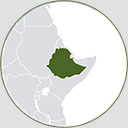
Location: Ethiopia
Implementer: ACDI/VOCA
Timeframe: 2011–2016
Key Interventions: Value chain competitiveness; access to finance; improving the enabling environment; public–private partnerships; innovation grants
USAID is linking its Agribusiness and Marketing Development Project (AMDe) with a collaborative initiative of the Ethiopian Government and multilateral donors known as the Agricultural Growth Program (AGP). Seeking to enhance the competitiveness of the chickpea, coffee, honey, maize, sesame, and wheat value chains, AGP-AMDe conducted an analysis to understand the main barriers to food and nutrition security in the target area and to determine the messages most likely to facilitate behavior change (in the form of improved nutrition) among client-beneficiaries. It found that apart from economic constraints, a limited availability of nutrient- dense foods in the market and the lack of appropriate nutrition knowledge among households with children under two were factors constraining improvements in nutritional status. AGP-AMDe attempts to integrate nutrition-sensitive interventions into the target value chains in a sustainable way. Both its value chain training and its outreach strategy, primarily to farmer cooperatives, incorporate messages encouraging families to a) invest their increased incomes on dietary diversity, including micronutrients and increased protein consumption; b) budget for nutritious foods yearround; and c) improve household hygiene and sanitation facilities. The nutrition messages are distributed through women’s groups and at farmer field days, farmer cooperative meetings, and other venues through printed materials translated into local languages.
Opportunities for Nutrition Linkages
Following the agricultural income pathway, AGP-AMDe pushes stakeholders to invest in the purchase and consumption of more diverse, nutritious foods year-round. Training and awareness-building efforts are informing decisions on investing in health and nutrition. Specific pathway components included by AGP-AMDe include:
Food Access: AGP-AMDe encourages smallholders to produce crops for sale through a market-led approach and provides agricultural extension support for farm diversification activities, such as animal production and intercropping for improved food access and dietary diversity.
Nutrition Knowledge: Nutrition messages, integrated into value chain activities, use language familiar to farmers—for instance, comparing the benefits to the family of diversifying diets to the benefits of growing a diversity of crops for the sustainable health of the land.
Women’s Empowerment: While recognized as a key pillar of AGP-AMDe, the activity’s strategies for increasing women’s control of income and linking empowerment, as well as time and energy expenditures, to nutrition could be more explicit.
Diet: Addressing limited availability of nutrient-dense foods in local markets, AGP-AMDe is helping increase the availability and affordability of fortified wheat flour for local and national consumption.
Conclusions and Observations on the Application of Pathways and Principles
Programming Principles
- Incorporate explicit nutrition objectives and indicators into design.
- Assess the local context.
- Target the vulnerable and improve equity.
- Collaborate and coordinate with other sectors.
- Maintain or improve the natural resource base, particularly water resources.
- Empower women.
- Facilitate production diversification, and increase production of nutrient-dense crops and livestock.
- Improve processing, storage, and preservation of nutritious food.
- Expand market access for vulnerable groups, and expand markets for nutritious foods.
- Incorporate nutrition promotion and education that builds on local knowledge.
The pathways and principles are useful frameworks for exploring how current interventions are working to achieve nutrition goals. The vignettes in this brief highlight the opportunity to support improved nutrition, provided that agriculture activities include interventions to ensure households are spending increased income, at least in part, on improved diets. Other important investments toward nutrition, such as water, hygiene and sanitation, and health care, are not explicitly highlighted by the above vignettes but may be equally important depending on the context. The examples underscore the interconnectedness of the income and production pathways; smallholder farmers have to make decisions about producing cash crops versus food crops for home consumption while assuring adequate nutrition for women and young children. Feed the Future activities have a key role to play in ensuring that these decisions are informed by knowledge of the importance of improving nutrition—via adequate quantity, quality, diversity, and accessibility of food.
The two vignettes in this brief further demonstrate the necessity of applying key programming principles for improving nutrition through agriculture while working along the agricultural income pathway; the vignettes also illustrate the efficacy of improving the natural resource base, empowering women, facilitating production diversification, expanding markets for nutritious foods, and incorporating nutrition education. All 10 programming principles (above right) can be factored into program design and implementation.
The pathways and principles provide a powerful framework for confirming assumptions and defining causal relationships between activity components, which are critical to activity design, monitoring, and evaluation. In applying the pathways and principles described above and illustrated in the vignettes, Feed the Future presents opportunities for learning at scale. Use of appropriate process monitoring indicators and sharing examples from the field are two effective ways for Feed the Future to build evidence on how generating income through agriculture can work to improve nutrition.
Footnotes
1 The conceptual pathways between agriculture and nutrition help us understand and measure how various agricultural investments or activities could improve access to food and health care; how they affect and are affected by the enabling environment; and how they ultimately affect the nutrition of women and children.
2 The principles are the current global consensus of key recommendations for improving nutrition through agriculture. Download the Principles
3 A doubling of Agriculture Gross Domestic Product (GDP) has shown to yield, on average, a reduction of between 15% and 60% in undernutrition, and is highly variable by country (Webb and Block 2012; Ruel and Alderman 2013). A doubling of GDP results in approximately a 70% gain in obesity (Ruel and Alderman 2013), and obesity is more highly correlated with agricultural growth than with overall economic growth (Webb and Block 2012).
4 USAID’s Bureau for Food Security has established a learning agenda for Feed the Future that includes a set of strategic questions intended to produce evidence, findings, and
answers primarily through impact evaluations, performance evaluations, and policy analysis. Through the learning agenda, Feed the Future will contribute to the body of knowledge
on food security to improve the design and management of interventions in the agriculture and nutrition sectors. Download the Learning Agenda
References
Central Statistical Agency. 2006. Ethiopia Demographic and Health Survey 2005. Addis Ababa, Ethiopia: Central Statistical Agency; and Calverton, Maryland: ORC Macro.
Food and Agriculture Organization of the United Nations (FAO). 2013. Synthesis of Guiding Principles on Agriculture Programming for Nutrition. Rome: FAO.
Herforth, Anna, and Jody Harris. 2014. Understanding and Applying Primary Pathways and Principles. Brief #1. Improving Nutrition through Agriculture Technical Brief Series. Arlington, VA: USAID/Strengthening Partnerships, Results, and Innovations in Nutrition Globally (SPRING) Project.
Ruel, Marie T., and Harold Alderman. 2013. “Nutrition-Sensitive Interventions and Programmes: How Can They Help to Accelerate Progress in Improving Maternal and Child Nutrition?” The Lancet 382:536–551. doi:10.1016/S0140-6736(13)60843-0.
Webb, Patrick, and Steven Block. 2012. “Support for Agriculture during Economic Transformation: Impacts on Poverty and Undernutrition.” Proceedings of the National Academy of Sciences of the United States of America 109:12309–12314. doi:10.1073/pnas.0913334108.
World Bank. 2007. From Agriculture to Nutrition: Pathways, Synergies and Outcomes. Washington, DC: The World Bank.
Recommended Citation
SPRING. 2014. Understanding the Agricultural Income Pathway. Brief 3. Improving Nutrition through Agriculture Technical Brief Series. Arlington, VA: USAID/Strengthening Partnerships, Results, and Innovations in Nutrition Globally (SPRING) Project.